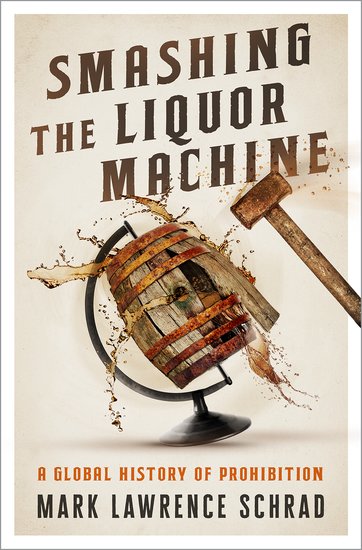By Johan Persson
The term “alcohol prohibition” as a description of the prohibition period in the United States originated around 1970. The claim may seem shocking, but before the 70’s the term barely appeared in writing. Instead, one wrote about bans on “liquor traffic“, “drink traffic” or similar terms. But these concepts disappeared at the same rate as “alcohol prohibition” gained ground.
This is not just a semantic difference. Before, during and for four decades after the Prohibition era, both Prohibitionists and opponents wrote about the production and sale of alcohol. But from the 1970s onwards, prohibition is instead described as aimed at the individual consumer. This is despite the fact that the Eighteenth Amendment to the United States Constitution never prohibited alcohol consumption, only manufacturing, sales and transportation.
Mark Lawrence Schrad, associate professor of political science at Villanova University, who discovered this change in language and discourse, links it to the breakthrough of neoliberalism during the same period. With neoliberalism, the distinction between the freedom of the market and the civic and political freedoms of the individual became blurred.
In countless books, the temperance and prohibition movement in the United States has been described as the enemy of freedom, as movements for politically reactionary and religiously conservative white rural people driven by a racist fear of minorities. The image has become well established in both popular culture and serious historical research.
In “Smashing the Liquor Machine: A Global History of Prohibition“, Mark Lawrence Schrad admits that he was also influenced by this image when he published “The Political Power of Bad Ideas” in 2010, a study of the Prohibition movement in the United States, Sweden and Russia.
But he also does something that is too uncommon both among researchers and pundits: he readily admits that he was wrong, that he misunderstood the temperance movement. Smashing the Liquor Machine is the result of Schrad’s attempt to correct this mistake by writing a new global history of temperance. With its 700 pages, of which 150 pages are footnotes, it is an impressive and completely unique contribution to the scientific research about temperance.
The book is an exciting and captivating story where we meet slavery opponents and suffragettes in the United States; anti-colonialism fighters in Botswana, Ireland and India; Russian Bolsheviks and Nordic Social Democrats; Christians, Hindus and Muslims.
It was the state and capital that were the enemy when movements for temperance and prohibition of intoxicating drinks emerged, not the individual alcohol consumer.”
Johan Persson
Instead of the neoliberal caricature of bigotted Puritans, from this scientific project a worldwide movement emerges that is closely intertwined with the other major progressive political projects of the 19th century: abolitionism, the suffrage movement, anti-imperialism, democratic nationalism, liberalism and socialism. A movement that saw itself as a freedom movement in the fight against powerful economic interests.
Schrad summarizes his thesis:
That prohibitionism was part of a long-term people’s movement to strengthen international norms in defence of human rights, human dignity, and human equality, against traditional autocratic exploitation. More precisely, temperance activists held that building the wealth of the state or of moneyed elites upon the misery and addiction of society was no longer appropriate.”
Mark Lawrence Schrad
Schrad reveals how the opponents of the temperance movement were a capital-strong and politically powerful industry, closely linked to militarism and colonialism. At the end of the Victorian era, one in five British Members of Parliament had financial interests in the brewing industry. Five of the fifteen largest British companies were breweries.
Before the advent of the modern income tax in the early twentieth century, all European empires relied on alcohol taxes to finance their military rearmament and colonial conquests. In the German Empire it accounted for twenty percent of the treasury, in Britain for 23 percent and in Tsarist Russia for 26 percent. No wonder then that Tsar Alexander II violently suppressed attempts to create a Russian temperance movement similar tothe American model. It was a direct threat to his war treasury.
It was the state and capital that were the enemy when movements for temperance and prohibition of intoxicating drinks emerged, not the individual alcohol consumer. Often these movements were supported by society’s most marginalized: women, people of color, indigenous people and colonized ethnic groups.
Schrad’s historical method is the biographical one. The movements are depicted through individuals who through their lives personified the connection between temperance and progressive politics. The most captivating character among them is William E. “Pussyfoot” Johnson, an almost superhuman character who for fifty years seems to have been constantly at the center of the global temperance cause. Perhaps one suspects that the book first emerged from a project to write “Pussyfoot” Johnson’s biography.
The biographical method is the book’s only real weakness. Schrad obviously has great sympathy for the social democrats and radical liberals of the early 20th century and likes to immerse himself in their lives. A stricter editor had deleted these extensive biographical chapters and made the book less brick-heavy. Almost the entire chapter on Sweden is devoted, for example, to Hjalmar Branting, a person who can be said to be quite peripheral in Swedish temperance history.
However, there is a point to the biographical approach. It shows how other historians and biographers have ignored the central role of the temperance issue in these people’s lives and struggles.
The struggle for temperance was an integral part of the fight against slavery, for women’s suffrage, for indigenous rights, against colonialism and for improvements for the working class.”
Johan Persson
“All great reforms go together,” wrote Frederick Douglass, the escaped slave who became one of the most eminent intellectuals of his time. He often recounted how slaveholders used alcohol to oppress and divide slaves, and his abolitionism was closely linked to his temperance. Still, most biographies of Douglass, including the 900-page Pulitzer Prize-winning “Frederick Douglass: Prophet of Freedom“, completely conceal his temperance cause.
Not even a progressive standard work like Howard Zinn’s “A People’s History of the United States” mentions the temperance movement more than in passing. The pre-understanding of the struggle for temperance and the prohibition of intoxicating drinks as a reactionary, racist and religious culture war seems to make it easier to conceal its existence than to explain why it was such an integral part of the fight against slavery, for women’s suffrage, for indigenous rights, against colonialism and for improvements for the working class.
Smashing the Liquor Machine is a book that everyone interested in the history of temperance should read. For a Swedish reader, its central thesis does not come as a major surprise. We are used to thinking of the temperance movement as one of the great democratic social movements in the history of our country. This is entirely due to the fact that Sweden still has a thriving temperance movement that is capable of writing its own history. The alternative is that someone else would do it.
This guest expert blog post is a re-publication authorized by the author. The blog post appeared first on April 02, 2022 in Swedish under the title “Smashing the Liquor Machine: A Global History of Prohibition” written by Johan Persson, on the website of the Swedish Society for the History of Temperance.
About Our Guest Expert
Johan Persson
Johan Persson is a board member of the Swedish Society for the History of Temperance, an administrator at the Swedish Youth Temperance Association (UNF) and an occasional culture writer. His interests include the history of social movements, contentious politics and the political uses of history.
You can read more about the Swedish Society for the History of Temperance here.


